Chauci
Q168549Chauci (Greek: Καῦχοι): name of the inhabitants of the southern shore of the North Sea.
A Northern Tribe
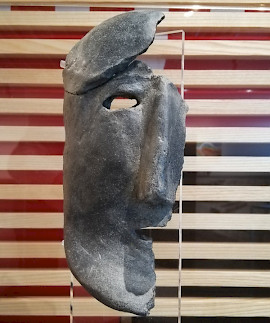
The Chauci are mentioned several times in the ancient sources, usually as examples of a poor and indigent tribe.note They were the inhabitants of the southern shore of the North Sea, which was, as the Roman author Tacitus correctly observes, a densely populated area. He continues with a highly idealized sketch of noble savages.
The Chauci are the noblest of the German races, a nation who would maintain their greatness by righteous dealing. Without ambition, without lawless violence, they live peaceful and secluded, never provoking a war or injuring others by rapine and robbery. Indeed, the crowning proof of their valor and their strength is, that they keep up their superiority without harm to others. Yet all have their weapons in readiness, and an army if necessary, with a multitude of men and horses; and even while at peace they have the same renown of valor.note
Just like the Frisians, who were divided in a minor and a major group, there were Lesser Chauci (in what is now the Dutch province of Groningen and the German region Ostfriesland) and the Greater Chauci (between the estuaries of the rivers Weser and Elbe).note
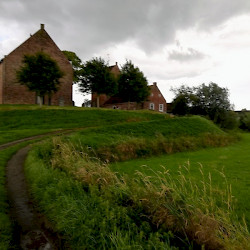 Ezinge, the wierde on a rainy day |
 Ezinge, Reconstruction of a "terpen" farm |
 Ezinge, Reconstruction of a "terpen" farm, interior |
 Ezinge, Reconstruction of a "terpen" farm |
Artificial Hills

The most remarkable aspect of the Chaucian way of life was that they were living on artificial hills, which are now known as terpen or wierden. We will call them terps. In fact, the name Chauci is derived from *Hauhae, "high-homers". The Roman officer Pliny the Elder gives an eyewitness account of the inhabitants of the land that was subject to the ebb and flood of the North Sea.
Here a wretched race is found, inhabiting either the more elevated spots of land, or else eminences artificially constructed, and of a height to which they know by experience that the highest tides will never reach. Here they pitch their cabins; and when the waves cover the surrounding country far and wide, like so many mariners on board ship are they: when, again, the tide recedes, their condition is that of so many shipwrecked men, and around their cottages they pursue the fishes as they make their escape with the receding tide.
It is not their lot, like the adjoining nations, to keep any flocks for sustenance by their milk, nor even to maintain a warfare with wild beasts, every shrub, even, being banished afar. With the sedge and the rushes of the marsh they make cords, and with these they weave the nets employed in the capture of the fish; they fashion the mud, too, with their hands, and drying it by the help of the winds more than of the sun, cook their food by its aid, and so warm their entrails, frozen as they are by the northern blasts; their only drink, too, is rainwater, which they collect in holes dug at the entrance of their abodes.note
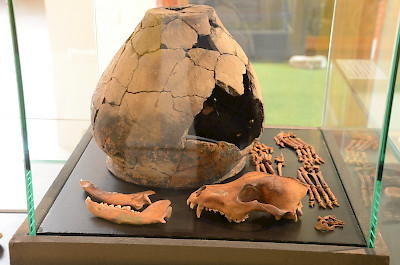
In the eyes of Pliny, accustomed to the towns of Italy and the comfortable military base at Xanten, the terp-people lived in abject poverty. However, his observations are biased, and, in his efforts to adequately illustrate the misery of their conditions, his description is inconsistent. After all, if the land was so poor that not even trees could grow there, then where did the people get the wood to build the stilts under their huts and cottages that Pliny had seen? In fact, it was not nearly as bad as he paints it.
The Chaucian Way of Life

The coastal area was of course open to the sea and was flooded twice a day. The first terps were built in the fifth century BCE and continued to be heightened. At first, they contained just one farm-house, but later, they could contain several houses (e.g., Ezinge) and even villages (e.g., Feddersen Wierde).
Unlike Pliny reports, the terp-dwellers did not sit down to meals of wild game, but their diet was more varied. The archaeologists at Ezinge, one of the main excavations in the Netherlands, discovered that the ancient inhabitants of this artificial hill collected eggs and hunted birds and seals. Furthermore, they had at their disposal vast stretches of pastureland on the mud flats, where cattle and, especially, sheep grazed. Sometimes they engaged in farming behind low dikes. And although the soil was saline, it was still possible to grow barley, flax, and pigeon beans on it.
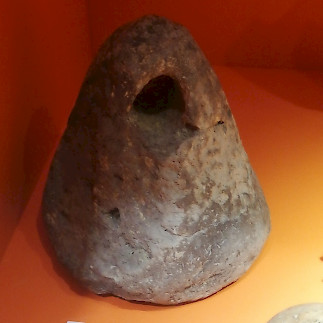
As the Roman writers were fixated by the idea that those living on the edge of the world were barbarians, they failed to see that, in the lands around the North Sea, barter was a very important part of the economy. The Chauci (and their neighbors, the Frisians) not only exported cheese, salt, wool, leather, and sheep, but they were also a link in the transit chain for slaves, hides, and amber. So many Roman coins have been found that it is assumed that they played a role in economic exchange, though more for hoarding than as a means of payment.
The Roman troops on the Rhine were among their most important customers; therefore, it is not so odd that, in the terps, glass, pottery, jewelry, and statuettes of Roman gods were found that had been produced in more southerly regions.
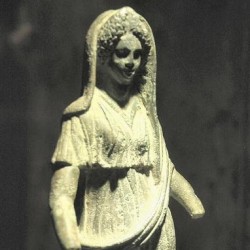 Krangeweer, Domitia Longina as Juno |
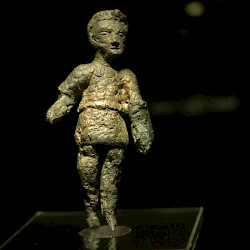 Ezinge, Statuette of a charioteer |
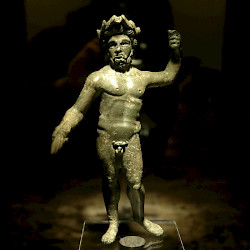 Ezinge, Figurine of Jupiter |
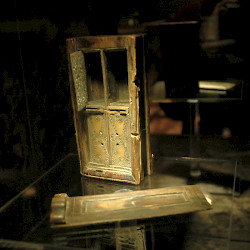 Eenum, Pyxis |
Furthermore, the Chauci and Frisians sailed up the coasts of the lands that are now called England, Flanders, and Denmark. Chaucian pirates harassed the Romans in the North Sea. Other seafarers had more peaceful intentions and engaged in trade. Consequently, the German cultures along the North Sea began to influence each other – one can speak of a "North Sea culture" – and this culture would spread to England in the fifth century. The oh-so-miserable way of life of the Chauci, as described by Pliny, was not so miserable and most definitely had a future.
The Chauci and Rome

The Chauci were subjected by the Roman general Drusus. According to Cassius Dio, whose account dates to the third century CE but survives more or less complete, this happened in 12 BCE.note Livy, who was a contemporary but whose account is known only in an abridged version, appears to date it in 11.note In 5 CE, general Tiberius, the future emperor, forced the Chauci to pay tribute. Velleius Paterculus was an eyewitness:
The Cauchi were again subjugated. All the flower of their youth, infinite in number though they were, huge of stature and protected by the ground they held, surrendered their arms, and, flanked by a gleaming line of our soldiers, fell with their generals upon their knees before the tribunal of the commander.note
It is very likely that in 9 CE, the Chauci joined the German insurrection that culminated in the battle in the Teutoburg Forest. The evidence is mixed, but in 40/41, one of the lost legionary eagles was recovered among the Chauci,note which is a very strong indication that they had taken part in the war against the Romans. The general who reconquered the eagle standard, Aulus Gabinius Secundus, was awarded the honorific titel Chaucicus.
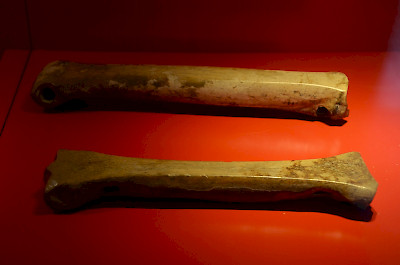
The Chauci did not succeed in regaining their independence during the insurrection in 9. Tacitus mentions a military unit in their county during the first regnal years of Tiberius.note This may have been at Bentumersiel, close to the mouth of the river Ems, where archaeologists have found many Roman objects.
Pirates, Rebels, and Auxiliaries
Several years later, in c.47 CE, the Roman commander Corbulo defeated a Cananefate named Gannascus, who had led a band of Chaucian pirates.note It is likely that it was on this occasion that Pliny the Elder observed the "boats of the German pirates made from dug-out tree trunks".note Another group of Chaucian pirates is mentioned in 173 CE. Evading the Rhine frontier, they attacked the coastal area of what is now called Flanders. Here, they were defeated by Didius Julianus, the future emperor.note
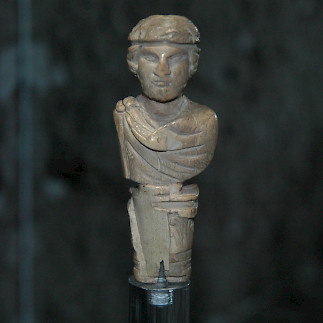
Chauci are also mentioned as enemies of the Ampsivarii,note who lived along the river Ems, and as joining the Batavian Revolt in 69-70.note One of these bands could be overcome without military help by the inhabitants of Cologne.note In all these cases, the groups must have been small: it is unlikely that there was a central government of the two Chaucian tribes.
Other Chaucian men joined the Roman army as auxiliary soldiers. They are mentioned several times in Tacitus' Annals.note Archaeologists have found many Roman military objects on the terps, which prove close cooperation between the Roman army and Chaucian allies.
Late Antiquity
In the third century CE, the Dutch coastal regions were abandoned. When they were repopulated in Late Antiquity, the settlers were Saxons, arriving from the east. The New History of the Byzantine author Zosimus may contain a reference to Chauci being integrated in a Saxon army in about 360 CE, but this presupposes a spelling error.note
One of the last references to the Chauci is in a speech by Claudian, who in 400 CE mentions the Chauci as inhabitants of the far bank of the river Rhine.note This reference may be topical. It is also possible that the Hugas, whose leader Daeghrefn was squeezed to death by a young Beowulf, as is mentioned in the Anglo-Saxon epic with that name,note are in fact the Chauci.
The terps remained in use. Today, they are remarkable for the charming churches, which often date back to the Middle Ages.
 Ezinge, Skull of a dog |
 Groningen, Cullender for processing of sea salt |
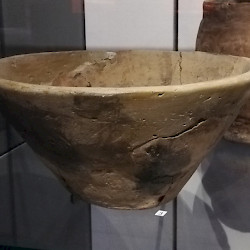 Heveskesklooster, Pottery |
 Ezinge, Flute |
 Ezinge, Loomweights |
 Ezinge, Millstone |
 Ezinge, Late ancient pottery |
 Ezinge, Urn |